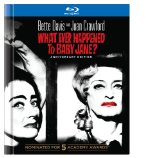| Reviews & Columns |
|
Reviews DVD TV on DVD Blu-ray 4K UHD International DVDs In Theaters Reviews by Studio Video Games Features Collector Series DVDs Easter Egg Database Interviews DVD Talk Radio Feature Articles Columns Anime Talk DVD Savant Horror DVDs The M.O.D. Squad Art House HD Talk Silent DVD
|
DVD Talk Forum |
|
|
| Resources |
|
DVD Price Search Customer Service #'s RCE Info Links |
|
Columns
|
|
|
What Ever Happened to Baby Jane: 50th Anniversary
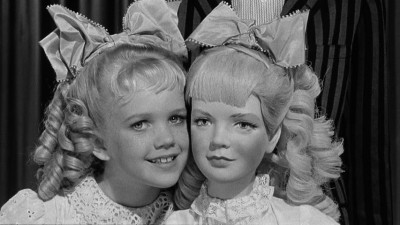
Please Note: The images used here are taken from the 2006 standard-definition DVD release, not the Blu-ray edition under review.
Robert Aldrich's 1962 classic What Ever Happened to Baby Jane? has a reputation that precedes it, for better and worse. It's long been best known and beloved as a thick slice of camp, providing essential cultural nourishment to 1,001 ingenious drag queens and other varieties of wasp-witted diva. But its aura seems, to this writer's mind, to float a bit too free of the actual film, which is something rather different than its reputation (or its cheesy "horror"-film posters/DVD cover, which have thankfully been jettisoned for this long-awaited new Blu-ray release) may suggest to a neophyte, and, I would submit, a lot more meaningful and disturbing than might be implied by the many easy laughs and campy tributes it's inspired over the decades. Yes, it contains the last unforgettable gasps of two great stars, apparently past their prime and open for ridicule (a ridicule that's often seemed to me at least somewhat unfair and overly gleeful). Yes, they do seem to be parodying themselves, smashing in the screen personae they so carefully built over the preceding decades of Hollywood's Golden Age, when they fought, won, and thrived within the studio system, each in her own way bending it to her titanic, endlessly fascinating will. And yes, it's hysterical in the conventional sense that it does offer many an overripe line reading or falling-short of the "horror" it's ostensibly supposed to contain that makes you laugh. But it's hysterical in a more lingering, actually nightmarish way, too. One can only guess about whether any one or all of its authors -- Crawford, Davis, Aldrich, screenwriter Lukas Heller -- were in on the full extent of what they were all creating together, but when you actually sit down and watch it from beginning to end, this hilarious (it's true), horrifying film is nothing less than the last poison-pen letter written with real, disappointed passion, sting, and bite that Golden-Age Hollywood would ever merit. This is literal hysteria -- shrill, shrieking, uncontrollable -- brought on not by comedy, but by some disorienting, deranging laughing-gas administered to dull the pain, not just of the inevitable decline of movie stars, but of the decline of "the movies" themselves at a point when TV had overtaken them, the studios were on an irreversible slide into moribund mediocrity, and the dream factory itself could only sputter under the weight of its inescapable disillusion.
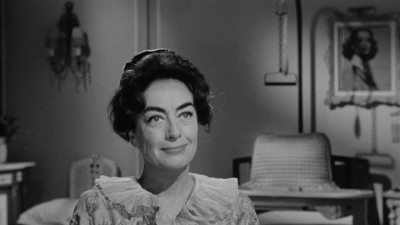
The film's timeline hews close to that of the rise and fall of "the movies," though most of the screen time is spent after the television judgment day that ended the reign of the flickers. The prologue takes us from 1917 -- when the spoiled, brattish meal-ticket Baby Jane Hudson, the most popular draw in her family's little traveling vaudeville act, sings her signature tune, "I'm Writing a Letter to Daddy," to an enraptured crowd, only to disgust them (and her timid mother and sister, Blanche, who live meekly oppressed in starpower-driven daddy and Jane's shadows) with her behavior when she throws a tantrum within sight and earshot of a horde of autograph-seekers -- to 1935, when the more serious artist of the two, Blanche, has found renown and success as a movie star. The once popular Jane must subsist in the picture biz on her sister's pitying generosity and her own self-medicating propensity to alcoholism and other scandalous acting out; success as a child actor has been a trap, and it's one she will never outgrow or escape. After the industry-wide love and admiration for Blanche and directors' and producers' catty disgust for the incorrigible Jane has been made clear for us, the opening credits come up on the late-night car accident that sets the stage for the rest of the film, in which Blanche's career is ended when she's crippled and left in her drunken, resentful sister's care.
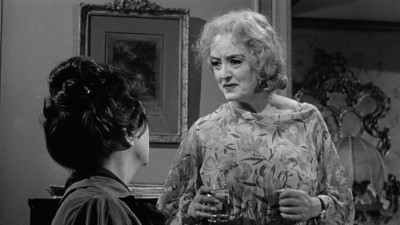
The car-crash credits complete the 1917-1935-"yesterday" arc of the timeline, and now, it seems just yesterday, a new, cheerfully prosperous, post-War crowd of pop-music loving Southern Californian middle-class suburbanites has grown up around the intimidating, anachronistic barred windows and ivied walls of the Italianate mansion where the once-celebrated actress and her nearly-forgotten child-star sister live as virtual shut-ins. The Hudson sisters' chipper, anodyne neighbors desultorily watch Blanche's great films on TV while the star languishes next door, but neighborly gestures are rebuffed by Jane, the only one who ever briefly ventures out the house and who, with decades of embittered rage and stunted craving for public admiration festering in her, stands with increasing, frightening purpose between her wheelchair-bound sister and the outside world. Bette Davis's Jane is, physically and persona-wise, a work of art: Far, far more significant than the famous "But'chya ARE, Blanche, ya ARE in that wheelchair!" lines are the finely-honed equal parts egotistical delusion and sheer, entirely unearned contempt for the little people that emanates from every starved, needy atom of this character's being. Jane is the pure star instinct thwarted, permanently stuck in her most popular little-girl mode, still dressing, in late middle age, in ludicrously childlike curls, coy and frilly gowns, and slathered-on silent-movie makeup. The effect is grotesque, at first extremely funny, but coming to seem very apt and progressively more disturbing as the film goes on. Jane is Gloria Swanson in Sunset Boulevard a further 12 fruitless years on (or, more recent and real, Michael Jackson in his isolated, pitiable decline, or an ageing Charlie Sheen utterly losing it), at a nadir of anachronism and anonymity, and it's more frightening than any of the acts of intimidation and cruelty Jane inflicts on Blanche as she insanely plots a "comeback" to once and for all vanquish her sister and claim her rightful place as the most famous Hudson.
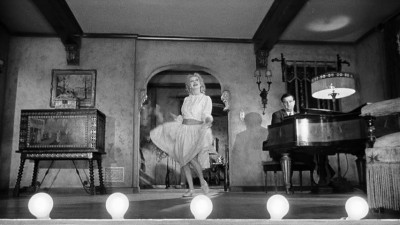
Forlorn Blanche, meanwhile, can watch her films on TV at the same time the neighbors do, with some melancholy but without getting sucked into the enraged abyss of failure and lost potential that has long since claimed her sister, to whom she perhaps unwisely tries to remain kind and indulgent, as she always has. Unfortunately for her, Jane has no intention of returning the favor; the film's main plotline consists of a Misery-like progression of Jane's bolder and bolder attempts to bring her sister, with her charm-school diction and many fulfilled artistic ambitions, down to her level, removing the few contacts Blanche has with the world outside, shutting her deep in the dank shadows of their once-glamorous Hollywood abode, taunting and verbally/physically abusing her, killing her off metaphorically (and, it seems more and more likely, literally) so that she will never again be subject and beholden to Blanche's pitying condescension and can finally restore herself to her place as daddy's -- and the world's -- favorite. Crawford has less to do here than Davis (the tensions between the actresses are legend and juicy, but not so directly relevant to the film), but her role is equally important; Blanche is the embodiment of genteel, respectable, self-congratulatory, Oscars-ceremony Hollywood, clashing against Davis's loud, insistent reminder of movies' roots as cheap, vulgar, quasi-vaudevillian entertainment for the masses. Crawford's comparatively bland pleasantness pays off big when the film's twist ending, revealed within a breathtakingly prolonged denouement, renders moot, in the final analysis, the question of the title and makes different questions -- "Who really created this overgrown 'Baby Jane'?" and "Who is really responsible for this nightmare of fame, rancor, and mutual disgust?" -- troublingly central. As far as the film's supporting players, Maidie Norman (Written on the Wind) as Elvira, the Hudsons' African-American maid and the film's one sane character, offers an intermittent solid center of calm, plainspoken reason, while Victor Buono, as the fat mama's-boy Englishman recruited by Jane as her pianist, adds an extra dash of arsenic to the film's poisonous brew: He's straight out of The Day of the Locust, a desperate, grotesque L.A. outcast drowning in the chasm between the perceived glamour and creative opportunity of the City of Angels' most well-known "industry" and its sweatier, more mundane and desperate realities.
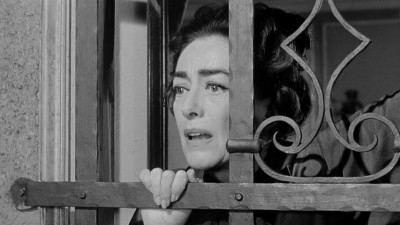
Aldrich's style here -- created with the superb cinematographer Ernest Haller (Rebel Without a Cause, who'd also worked with Crawford before, memorably photographing Mildred Pierce and Humoresque, and Davis, too, shooting Mr. Skeffington), with the score by DeVol veering between sinisterly playful and melodramatic -- is perfect. "Contrast" in this picture is something by turns beautiful within certain scenes, with wonderful chiaroscuro and too-bright whites playing resonantly off of too-black blacks -- and, something that exists to great effect between them, with an alternation between a much less beautiful by design, plain, flat, almost TV-like style, particularly in exteriors and in scenes that take place in Blanche's room, to jar against the more elaborately and elegantly designed classic-film lighting associated with interiors more preoccupied with Jane's spaces in these sad sisters' movie-haunted castle. The final sequence is something else -- perhaps the most unfairly overlooked, most shattering scene in the entire film. It is long, slow, as much something out of a European art film as a very-late-phase Hollywood "thriller." It's brilliantly shot, performed, and edited, and, while it may not be as explosive and blunt a conclusion as the iconic last scene in Aldrich's greatest film, it strongly resembles and recalls that ending by also being an apocalypse that takes place incongruously on a beach, leaving you gasping and creating deep-rumbling aftershocks you feel long after the screen fades to black. What Ever Happened to Baby Jane? is, in its own way, as downbeat, cool, and ruthlessly dissecting as the contemporaneous films of Antonioni, with "movie magic" and its ideals, history, and mythology, rather than the more general modern life/society the Italian master had on his mind, under its penetrating, too-clearly seeing microscope. It dares to ask a Pandora's box of a question, something beyond the pale and most disconcerting: What if Sunset Boulevard had looked into the future to find the idea of Hollywood glamor, greatness, and power in the appalling rubble to which it would inevitably be reduced in 1962, instead of its still-standing state in the less panicked, desperate 1950? The answer it offers is far from pretty, but it's both convincing and, in its way, absolutely stunning; if ever a film bilious and embittered to its very core could be said to be a masterpiece by dint of its eminent ability to convey those feelings through the tools of the medium, then this is the one.
(With thanks to Michael Kuntz for his knowledgeable aid and gentle fact-checking guidance.)
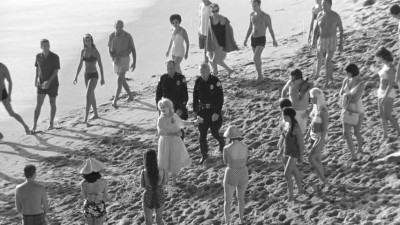
THE BLU-RAY DISC:
Like the previous Special Edition Warners DVD (which this release in most ways replicates), the Blu-ray disc re-mats the film -- now AVC/MPEG4-encoded and 1080p-mastered -- to 1.78:1 rather than the traditional theatrical matting of 1.85:1 (the negative ratio is 1.33:1). But this actually looks fine, doing no noticeable harm to Aldrich and Haller's compositions (for all we know, it's at least, if not more, respectful than the 1.85:1 matting). And the picture quality is fantastic: It's sharp and clear, all the contrasts and nuances of the black and white cinematography fully present and accounted for, no print wear or compression artifacts of any sort even remotely discernible, and a great retention of celluloid texture make for a truly top-notch visual presentation of the film.
Sound:The DTS-HD Master Audio 1.0 soundtrack presents the sound free of crackles, hiss, or other noise accrued over time; the restoration is wonderful. It would seem that either the mix in the source materials or some anomaly of the DTS sound mix prioritizes music over dialogue; there were moments when the latter seemed quite soft and others where the former was quite loud, but overall, this doesn't present a major problem, and the sound is very good. Language options include English SDH subtitles, French or Spanish audio, and French or Spanish subtitles.
Extras:The 50th anniversary Blu-ray edition is loaded up with the same extras as the 2006 two-disc DVD edition, with the added bonus of being housed in appealing new "digibook" packaging that offers nicely designed hardcover sturdiness and a 35-page booklet packed with trivia, stills, promotional items, and clippings related to the film.
--A feature commentary by Charles Busch and Charles Epperson (both acclaimed and legendary drag performers; Busch wrote/directed the Davis-tributary spoof Die Mommie Die!, while Epperson has performed brilliant drag shows for decades under the stage name "Lypsinka") that is a bit chattier, more gossipy, and more trivia-laden than the more in-depth commentary this reviewer generally prefers, but nevertheless offers a fair amount of well-informed and intelligent history, background, and aesthetic assaying of the film, its making, and how it works to be both casually enjoyable for giggles and gossip and worth listening in on in its entirety for further knowledge and frame of reference.
--"Bette and Joan: Blind Ambition," a 30-minute program made for the 2006 DVD release that also features Busch and Epperson, along with film historian Tom Toh, critic Paul Clinton, actress Carol Kane, and my own venerable DVDTalk.com colleague, the DVD Savant, Glenn Erickson (among too many other experts and fans to list off here) offering their two cents and some often fairly extensive and specialized knowledge/information about the two stars, their careers, and their famous going head to head in Baby Jane.
--"Behind the Scenes with Baby Jane," a fascinating, voiceover-narrated six-minute promotional piece made by the studio for the film's release. It captures Aldrich at work and detils the journey of the story from novel to screen while offering many a privileged look at production sketches, raw footage of the actresses in preparation for their scenes, and genuine on-set footage of the shoot in process, making it a delight for cinephiles and nascent filmmakers alike.
--A contemporaneous clip from The Andy Williams Show with the recently departed crooner introducing Davis for a sashay through the catchy "What Ever Happened to Baby Jane?" single (heard as an instrumental in the score) that she recorded with Debbie Burton as part of the film's promotion.
--All About Bette, a very worthy 45-minute program from 1993 made for the cable network that would become Turner Classic Movies. It's a full biography of Davis, with an in-depth rundown of her life and work illustrated by a cornucopia of film clips and snatches of Davis's many epigrammatic TV appearances, with the narration written by Newsweek critic David Ansen and spoken on camera and in voiceover by Jodie Foster, who clearly adores Davis as an actress and as a powerful Hollywood figure.
--Film Profile: Joan Crawford, a half-hour black-and-white BBC program (I would guess from sometime in the mid-70s) that covers Crawford's career but is centered around a long, in-depth, present-day in-studio interview with Crawford by BBC host Philip Jenkinson. It's a surprisingly candid Q&A, and though Crawford acts like a queen (what else would anyone expect?), there are unexpected (and possibly even genuine) moments of revelation and humility.
--Two trailers for the film, one the original from 1962 (incorporating some of the footage and generally way overselling the film's thrill factor, but in a fun way), and one a gaudy, gimmicky "remix" done for the 2006 special-edition DVD release that incorporates Davis's most famous and worn-out sound-bites from the film with the aforementioned Davis/Burton single (the only place in this package you can hear that sweet, odd bit of movie memorabilia, so it's worth a look despite its silliness).
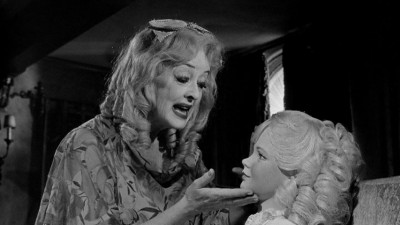
What Ever Happened to Baby Jane? may be the last film ever made with the beautifully realized dreams of Golden-Age Hollywood still stuck in its head; since it was conceived and shot in the early '60s, well after the most glorious coming-true of those dreams had last been tenable, it makes for a nightmarish, unhinged, disorienting, absolutely transfixing oddball nightmare of a film whose amusing, light conventional "horror" mask a disturbing, strangulating decrepitude -- a truly shocking, genuine horror, particularly for any deep-down movie-lovers who happen to find themselves in its grasp. Bette Davis and Joan Crawford both give their final great performances, bravely playing stars from another era, left far behind (and, in the end, quite literally "washed up"), who are finding the march of time into the current period much less than hospitable, with Davis's grown-up "baby" Jane reacting to their diminished station in a way that's bound to irrevocably degrade them both, finalizing her long, long descent into insanity and possibly killing her sister. This is what the long-ago promise of Hollywood, now betrayed, stale, rancid, and soon to be forgotten, looks like, and it is frightening in a more profound way than the bulk of criticism on the film that I know of has ever really given credence to. It's a much better-made, significant, intelligent film than its camp reputation might imply; deep and dark, it's the very last, unhappy chapter in a Hollywood book that was probably always too beautiful and good to be true, and its disillusionment and even outright cynicism are convincing and powerful enough to last over many, many viewings, more than earning it its ambivalent but permanent place in the canon. Highly Recommended.
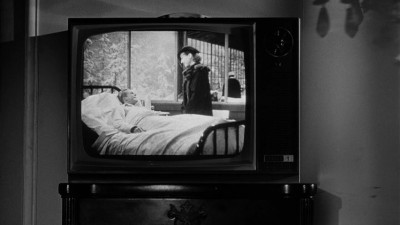
|
| Popular Reviews |
| Sponsored Links |
|
|
| Sponsored Links |
|
|
| Release List | Reviews | Shop | Newsletter | Forum | DVD Giveaways | Blu-Ray | Advertise |
|
Copyright 2024 DVDTalk.com All Rights Reserved. Legal Info, Privacy Policy, Terms of Use,
Manage Preferences,
Your Privacy Choices | |||||||









